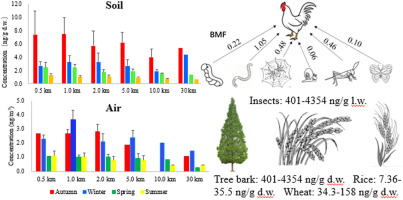Ecotoxicology and Environmental Safety ( IF 6.8 ) Pub Date : 2018-06-12 , DOI: 10.1016/j.ecoenv.2018.06.013 Yanyan Fang , Zhiqiang Nie , Jinzhong Yang , Qingqi Die , Yajun Tian , Feng Liu , Jie He , Jianyuan Wang , Qifei Huang

|
Soil, air, tree bark, rice, wheat, invertebrates, and chicken tissues around a typical endosulfan-contaminated site were analyzed in each season in each of two years. The total endosulfan (the sum of α-, β-endosulfan and endosulfan sulfate) were significantly different in soil and air samples collected in the four seasons (P < 0.01) and the mean concentrations were 6.53 ng/g dry weight (d.w.) and 2.40 ng/m3, respectively, in autumn, 3.32 ng/g d.w. and 2.48 ng/m3, respectively, in winter, 2.10 ng/g d.w. and 0.93 ng/m3, respectively, in spring, and 1.03 ng/g d.w. and 0.83 ng/m3, respectively, in summer. The total endosulfan concentrations in tree bark, rice, wheat, and invertebrates were 23.0–278 (mean 95.5) ng/g d.w., 7.36–35.5 (mean 17.4) ng/g d.w., 34.3–158 (mean 83.1) ng/g d.w., and 401–4354 (mean 2125) ng/g lipid weight, respectively. The total endosulfan concentrations in the chicken gizzard, heart, liver, and meat samples were 552, 212, 699, and 221 ng/g lipid weight, respectively. The endosulfan concentrations in soil, air, and biota around the site were strongly influenced by endosulfan emissions from the site, and the concentrations had decreased to half the initial concentrations six months after endosulfan production stopped. The invertebrate and chicken bioconcentration and biomagnification factors indicated that endosulfan accumulated in the invertebrates and chicken tissues was slightly biomagnified by chickens.
中文翻译:

污染地点周围土壤,空气和生物区系中硫丹浓度的空间分布和季节性变化
在两年中的每个季节中,对典型硫丹污染地点周围的土壤,空气,树皮,水稻,小麦,无脊椎动物和鸡组织进行了分析。在四个季节采集的土壤和空气样品中,总硫丹(α-,β-硫丹和硫酸硫丹的总和)存在显着差异(P <0.01),平均浓度为6.53 ng / g干重(dw)和秋季分别为2.40 ng / m 3和冬季分别为3.32 ng / g dw和2.48 ng / m 3,春季和春季分别为2.10 ng / g dw和0.93 ng / m 3和1.03 ng / g dw和0.83 ng / m 3分别在夏天。树皮,水稻,小麦和无脊椎动物中硫丹的总浓度为23.0–278(平均95.5)ng / g dw,7.36–35.5(平均17.4)ng / g dw,34.3–158(平均83.1)ng / g dw和401-4354(平均2125)ng / g脂质重量。鸡g,心脏,肝脏和肉类样品中的总硫丹浓度分别为552、212、699和221 ng / g脂质重量。该地点周围土壤,空气和生物群中的硫丹浓度受到该地点硫丹排放量的强烈影响,在硫丹生产停止六个月后,该浓度已降至初始浓度的一半。


























 京公网安备 11010802027423号
京公网安备 11010802027423号